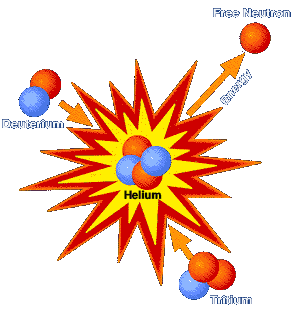
 |
The Sun - power house |
|
| |
 Vital StatsLive image: click to enlarge. Middle AgedThe Sun has existed for 5 billion (5,000,000,000, or 5×109) years. It is one of 150 billion stars in our galaxy, The Milky Way. Despite consuming 5 million tonnes of Hydrogen every second, there is enough material left for it to exist for another 5 billion years. A Typical StarStars can exist with between 1/20 and 70× the mass of our Sun, making it somewhat average. Heavier stars have much shorter lifetimes, since their greater gravity increases the rate of fusion. This also makes them hotter and brighter than our Sun, whose surface temperature is about 6000K. More on stars. Fusion PerfectedOn Earth, humans use Nuclear Fission to produce energy for some of our electricity supply. This is somewhat inefficient, and produces very dangerous nuclear waste. The Sun uses the technically more difficult Nuclear Fusion to produce its energy: 3×1026 joules per second! (3×1026 W). 
Fig. 1: Fusion of Hydrogen into Helium In studying the Sun, we humans have learned how to produce energy from Nuclear Fusion. This century, it may become our main source of energy.
Revealing SpectrumOnce it was learned that the Sun is just an ordinary star, scientists on earth realised that if we learned about the sun, we were learning about the stars. In the diagram below, the spectrum of the Sun is shown. As you can see, there are lots of unexpected black lines. 
Fig. 2: The Solar Spectrum Spectral LinesThe black lines seen in the solar spectrum are Fraunhofer lines. They indicate the presence of chemical elements in the Sun. Light from other stars is similar - from their spectra we learn about what they're made from. Click for more. |
|
|
Sun | Mercury | Venus | Earth | Moon | Mars | Asteroids | Jupiter | Saturn | Uranus | Neptune | Pluto | X | Kuiper | |